
List of the largest cannon by caliber
Encyclopedia
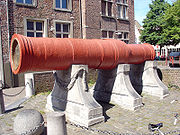
Caliber
In guns including firearms, caliber or calibre is the approximate internal diameter of the barrel in relation to the diameter of the projectile used in it....
size. For the purpose of this list, the development of supergun
Supergun
A supergun is an extraordinarily large artillery piece. This size may be due to a large bore, barrel length or a combination of the two. While early examples tended to have a fairly short range more recent examples sometimes had an extremely high muzzle velocity resulting in a very long...
s can be divided into three periods, based on the kind of projectiles used:
- Stone balls: Cannon of extraordinary bore, which fired stone balls, were first introduced at the turn of the 14th to 15th century in Western EuropeWestern EuropeWestern Europe is a loose term for the collection of countries in the western most region of the European continents, though this definition is context-dependent and carries cultural and political connotations. One definition describes Western Europe as a geographic entity—the region lying in the...
. Following a logic of increasing performance through size, they had evolved from small handgunHandgunA handgun is a firearm designed to be held and operated by one hand. This characteristic differentiates handguns as a general class of firearms from long guns such as rifles and shotguns ....
s to giant wrought-iron or cast-bronze bombardBombard (weapon)A bombard is a large-caliber, muzzle-loading medieval cannon or mortar, used chiefly in sieges for throwing heavy stone balls. The name bombarde was first noted and sketched in a French historical text around 1380. The modern term bombardment derives from this.Bombards were usually used during...
s within a span of just several decades.
- Iron balls and shot: By the 16th century, however, a general switch from stone balls to smaller, but much more effective iron projectiles was in full swing. This and the parallel tendency towards standardized, rapid-firing cannon made the enormously costly and logistically demanding superguns soon obsolete in the European theatre (with the exception of the odd showpiece).
- Explosive shells: In the industrial ageIndustrial AgeIndustrial Age may refer to:*Industrialisation*The Industrial Revolution...
, artillery was again revolutionized by the introduction of explosive shellsShell (projectile)A shell is a payload-carrying projectile, which, as opposed to shot, contains an explosive or other filling, though modern usage sometimes includes large solid projectiles properly termed shot . Solid shot may contain a pyrotechnic compound if a tracer or spotting charge is used...
, beginning with the Paixhans guns. Breakthroughs in metallurgy and modes of production were followed up by new experimentation with super-sized caliber weapons, culminating in the steel colossi of the two World WarWorld warA world war is a war affecting the majority of the world's most powerful and populous nations. World wars span multiple countries on multiple continents, with battles fought in multiple theaters....
s. In the post-war era, the development of extremely overpowered artillery was gradually abandoned in favour of missileMissileThough a missile may be any thrown or launched object, it colloquially almost always refers to a self-propelled guided weapon system.-Etymology:The word missile comes from the Latin verb mittere, meaning "to send"...
technology, while heavy guns are still demanded by various arms of the service.
As artillery pieces of the different periods, due to the dissimilar characteristics of their projectiles, are practically incommensurable in terms of their bore size, the following list is split into three sections.
Stone balls
Heyday: 14th to 15th century| Caliber Caliber In guns including firearms, caliber or calibre is the approximate internal diameter of the barrel in relation to the diameter of the projectile used in it.... (mm) | Name | Type | Produced | Place of origin | Made by | |
|---|---|---|---|---|---|---|
 |
890The bombard has a conical bore of 82.5–90 cm. | Tsar Cannon Tsar Cannon The Tsar Cannon is a huge cannon on display on the grounds of the Moscow Kremlin. It was cast in 1586 in Moscow, by the Russian master bronze caster Andrey Chokhov. Mostly of symbolic impact, it was never fired in war... |
Bombard Bombard (weapon) A bombard is a large-caliber, muzzle-loading medieval cannon or mortar, used chiefly in sieges for throwing heavy stone balls. The name bombarde was first noted and sketched in a French historical text around 1380. The modern term bombardment derives from this.Bombards were usually used during... |
1586 | .svg.png) Tsardom of Russia Tsardom of RussiaTsardom of Russia The Tsardom of Russia was the name of the centralized Russian state from Ivan IV's assumption of the title of Tsar in 1547 till Peter the Great's foundation of the Russian Empire in 1721.From 1550 to 1700, Russia grew 35,000 km2 a year... |
Andrey Chokhov Andrey Chokhov Andrey Chokhov, also spelled Chekhov was one of the most prominent Russian casters... |
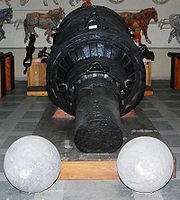 |
820The bombard has a conical bore of 76–88 cm. | Pumhart von Steyr Pumhart von Steyr The Pumhart von Steyr is a medieval supergun from Styria, Austria, and the largest known wrought-iron bombard by caliber. The cannon was produced in the early 15th century and could fire, according to modern calculations, a 690 kg stone ball around 600 m, loaded with 15 kg of powder and set up at... |
Bombard Bombard (weapon) A bombard is a large-caliber, muzzle-loading medieval cannon or mortar, used chiefly in sieges for throwing heavy stone balls. The name bombarde was first noted and sketched in a French historical text around 1380. The modern term bombardment derives from this.Bombards were usually used during... |
House of Habsburg,  Holy Roman Empire Holy Roman Empire |
||
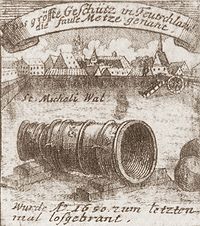 |
735The bombard has a conical bore of 67–80 cm. | Faule Mette Faule Mette The Faule Mette or Faule Metze was a medieval supergun of the city of Brunswick, Germany.... |
Bombard Bombard (weapon) A bombard is a large-caliber, muzzle-loading medieval cannon or mortar, used chiefly in sieges for throwing heavy stone balls. The name bombarde was first noted and sketched in a French historical text around 1380. The modern term bombardment derives from this.Bombards were usually used during... |
1411 | City of Brunswick Braunschweig Braunschweig , is a city of 247,400 people, located in the federal-state of Lower Saxony, Germany. It is located north of the Harz mountains at the farthest navigable point of the Oker river, which connects to the North Sea via the rivers Aller and Weser.... ,  Holy Roman Empire Holy Roman Empire |
Henning Bussenschutte |
 |
660 | Dulle Griet Dulle Griet The Dulle Griet is a medieval supergun from Ghent, Belgium. The wrought-iron bombard was constructed in the first half of the 15th century from 32 longitudinal bars enclosed by 61 rings... |
Bombard Bombard (weapon) A bombard is a large-caliber, muzzle-loading medieval cannon or mortar, used chiefly in sieges for throwing heavy stone balls. The name bombarde was first noted and sketched in a French historical text around 1380. The modern term bombardment derives from this.Bombards were usually used during... |
City of Ghent Ghent Ghent is a city and a municipality located in the Flemish region of Belgium. It is the capital and biggest city of the East Flanders province. The city started as a settlement at the confluence of the Rivers Scheldt and Lys and in the Middle Ages became one of the largest and richest cities of... ,  Holy Roman Empire Holy Roman Empire |
||
 |
635 | Dardanelles Gun or Great Turkish Bombard | Bombard Bombard (weapon) A bombard is a large-caliber, muzzle-loading medieval cannon or mortar, used chiefly in sieges for throwing heavy stone balls. The name bombarde was first noted and sketched in a French historical text around 1380. The modern term bombardment derives from this.Bombards were usually used during... |
1464 | Ottoman Empire Ottoman Empire The Ottoman EmpireIt was usually referred to as the "Ottoman Empire", the "Turkish Empire", the "Ottoman Caliphate" or more commonly "Turkey" by its contemporaries... |
Munir Ali |
 |
520 | Faule Grete Faule Grete The Faule Grete was a medieval supergun of the Teutonic Order. The bronze bombard was cast in 1409 in the cannon foundry of the Marienburg by the gunfounder Heynrich Dumechen... |
Bombard Bombard (weapon) A bombard is a large-caliber, muzzle-loading medieval cannon or mortar, used chiefly in sieges for throwing heavy stone balls. The name bombarde was first noted and sketched in a French historical text around 1380. The modern term bombardment derives from this.Bombards were usually used during... |
1409 | Monastic state of the Teutonic Knights Monastic State of the Teutonic Knights The State of the Teutonic Order, , also Monastic State of the Teutonic Knights or Ordensstaat , was formed in 1224 during the Northern Crusades, the Teutonic Knights' conquest of the pagan West-Baltic Old Prussians in the 13th century.... |
Heynrich Dumechen |
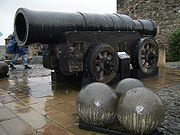 |
520 | Mons Meg Mons Meg Mons Meg is a medieval bombard which can be classed as a supergun, now located at Edinburgh Castle, Scotland. There are conflicting theories about its origins, but it appears from the accounts of Philip the Good, Duke of Burgundy that it was made to his order around 1449 and sent as a gift 8 years... |
Bombard Bombard (weapon) A bombard is a large-caliber, muzzle-loading medieval cannon or mortar, used chiefly in sieges for throwing heavy stone balls. The name bombarde was first noted and sketched in a French historical text around 1380. The modern term bombardment derives from this.Bombards were usually used during... |
1449 | Duchy of Burgundy Duchy of Burgundy The Duchy of Burgundy , was heir to an ancient and prestigious reputation and a large division of the lands of the Second Kingdom of Burgundy and in its own right was one of the geographically larger ducal territories in the emergence of Early Modern Europe from Medieval Europe.Even in that... ,  Holy Roman Empire Holy Roman Empire |
Jehan Cambier |
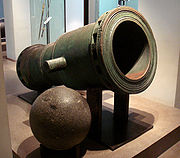 |
510The bombard has a conical bore of 45–58 cm. | Bombard Bombard (weapon) A bombard is a large-caliber, muzzle-loading medieval cannon or mortar, used chiefly in sieges for throwing heavy stone balls. The name bombarde was first noted and sketched in a French historical text around 1380. The modern term bombardment derives from this.Bombards were usually used during... |
1480 | Knights Hospitaller Knights Hospitaller The Sovereign Military Hospitaller Order of Saint John of Jerusalem of Rhodes and of Malta , also known as the Sovereign Military Order of Malta , Order of Malta or Knights of Malta, is a Roman Catholic lay religious order, traditionally of military, chivalrous, noble nature. It is the world's... |
||
Iron balls and shot
Heyday: 16th to 19th century| Caliber (mm) | Name | Type | Produced | Place of origin | Made by | |
|---|---|---|---|---|---|---|
| 280 | Kanone Greif | Scharfmetze ("medium size") | 1524 | Electorate of Trier | Master Simon | |
Twenty-inch (508 mm) Rodman and Dahlgren smoothbore cannons
Dahlgren gun
Dahlgren guns were muzzle loading naval artillery designed by Rear Admiral John A. Dahlgren USN, mostly used in the period of the American Civil War. Dahlgren's design philosophy evolved from an accidental explosion in 1849 of a 32-pounder being tested for accuracy, killing a gunner...
were cast in 1864 during the American Civil War. The Rodmans were used as seacoast defense. Although not used as intended, 2-20" Dahlgrens were intended to be mounted in the turrets of USS Dictator and USS Puritan
USS Puritan
USS Puritan may refer to:, , was a single-turret monitor that was never commissioned. She remained in the docks until 1874 when she was broken up and her name transferred to a new vessel., , was an Puritan-class monitor. After a long fitting out period, she was commissioned on 10 December 1896 and...
.
Explosive shells
Heyday: 19th to 20th century| Caliber Caliber In guns including firearms, caliber or calibre is the approximate internal diameter of the barrel in relation to the diameter of the projectile used in it.... (mm) | Name | Type | Produced | Place of origin | Made by | |
|---|---|---|---|---|---|---|
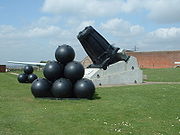 |
914 | Mallet's mortar Mallet's Mortar Mallet's Mortar was a British siege mortar built for, but never used in, the Crimean WarThe mortar was design by Robert Mallet. It was constructed in sections so that it could be transported.... |
Mortar Mortar (weapon) A mortar is an indirect fire weapon that fires explosive projectiles known as bombs at low velocities, short ranges, and high-arcing ballistic trajectories. It is typically muzzle-loading and has a barrel length less than 15 times its caliber.... |
1857 |  United Kingdom United KingdomUnited Kingdom of Great Britain and Ireland The United Kingdom of Great Britain and Ireland was the formal name of the United Kingdom during the period when what is now the Republic of Ireland formed a part of it.... |
Robert Mallet Robert Mallet Robert Mallet FRS , Irish geophysicist, civil engineer, and inventor who distinguished himself in research on earthquakes and is sometimes called the father of seismology.-Early life:... |
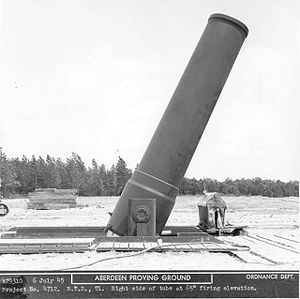 |
914 | Little David Little David Little David was the nickname of an American 36 inch caliber mortar used for test firing aerial bombs during World War II.-History:... |
Mortar Mortar (weapon) A mortar is an indirect fire weapon that fires explosive projectiles known as bombs at low velocities, short ranges, and high-arcing ballistic trajectories. It is typically muzzle-loading and has a barrel length less than 15 times its caliber.... |
1945 |  United States United States |
|
| 800 | Schwerer Gustav Schwerer Gustav Schwerer Gustav and Dora were the names of two massive World War II German 80 cm K railway siege guns. They were developed in the late 1930s by Krupp for the express purpose of destroying heavy fortifications, specifically those in the French Maginot Line... |
Railway gun Railway gun A railway gun, also called a railroad gun, is a large artillery piece, often surplus naval ordnance, mounted on, transported by, and fired from a specially designed railway wagon. Many countries have built railway guns, but the best known are the large Krupp-built pieces used by Germany in World... |
1941 |  Nazi Germany Nazi Germany |
Krupp Krupp The Krupp family , a prominent 400-year-old German dynasty from Essen, have become famous for their steel production and for their manufacture of ammunition and armaments. The family business, known as Friedrich Krupp AG Hoesch-Krupp, was the largest company in Europe at the beginning of the 20th... |
|
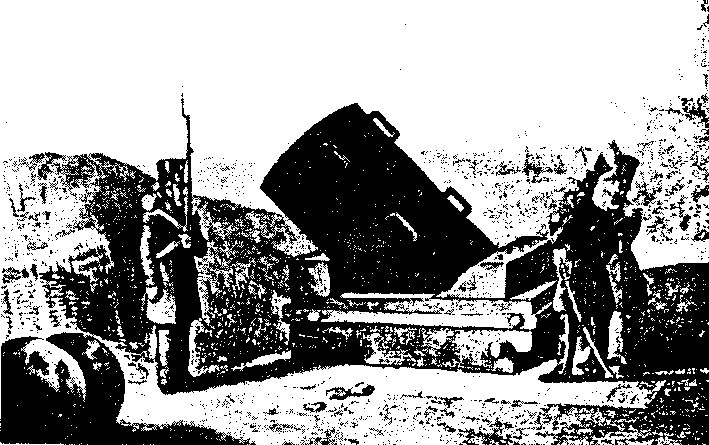 |
600 | Mortier monstre | Mortar Mortar (weapon) A mortar is an indirect fire weapon that fires explosive projectiles known as bombs at low velocities, short ranges, and high-arcing ballistic trajectories. It is typically muzzle-loading and has a barrel length less than 15 times its caliber.... |
1832 |  France FranceJuly Monarchy The July Monarchy , officially the Kingdom of France , was a period of liberal constitutional monarchy in France under King Louis-Philippe starting with the July Revolution of 1830 and ending with the Revolution of 1848... |
Henri-Joseph Paixhans Henri-Joseph Paixhans Henri-Joseph Paixhans was a French artillery officer of the beginning of the 19th century.Henri-Joseph Paixhans graduated from the École Polytechnique... |
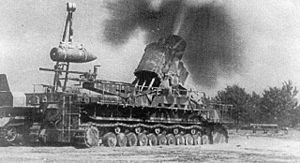 |
600 | Karl-Gerät | Mortar Mortar (weapon) A mortar is an indirect fire weapon that fires explosive projectiles known as bombs at low velocities, short ranges, and high-arcing ballistic trajectories. It is typically muzzle-loading and has a barrel length less than 15 times its caliber.... |
1940 |  Nazi Germany Nazi Germany |
Rheinmetall Rheinmetall Rheinmetall AG is a German automotive and defence company with factories in Düsseldorf, Kassel and Unterlüß. The company has a long tradition of making guns and artillery pieces... |
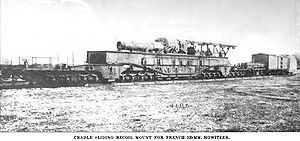 |
520 | Obusier de 520 modèle 1916 Obusier de 520 modèle 1916 The Obusier de 520 modèle 1916 was a French railroad gun that was built during World War I, but did not see service before the war ended. One gun was captured by the Germans after France surrendered in 1940 and used by them in the Siege of Leningrad... |
Railway howitzer Railway gun A railway gun, also called a railroad gun, is a large artillery piece, often surplus naval ordnance, mounted on, transported by, and fired from a specially designed railway wagon. Many countries have built railway guns, but the best known are the large Krupp-built pieces used by Germany in World... |
1918 |  France FranceFrench Third Republic The French Third Republic was the republican government of France from 1870, when the Second French Empire collapsed due to the French defeat in the Franco-Prussian War, to 1940, when France was overrun by Nazi Germany during World War II, resulting in the German and Italian occupations of France... |
Schneider et Cie Schneider Electric Schneider Electric is a French global company. It was founded in 1836 by two brothers, Eugène and Adolphe Schneider.In the first part of the 20th century, Schneider et Cie associated itself with Westinghouse Systems, a major international electrical group at the time. The group began manufacturing... |
| 508 | 508 mm/9.6 smooth-bore naval gun | Naval gun | 1868 |  Russian Empire The Russian Empire was a state that existed from 1721 until the Russian Revolution of 1917. It was the successor to the Tsardom of Russia and the predecessor of the Soviet Union... |
Motovilikha Plants Motovilikha Plants Motovilikha Plants is a Russian metallurgical and military equipment manufacturer. The full official name of the company is Open stock venture for special machinery and metallurgy "Motovilikha Plants" .*... |
|
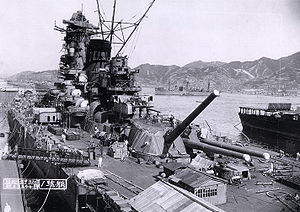 |
460 | 40 cm/45 Type 94 40 cm/45 Type 94 The Japanese was the largest bore gun ever mounted on any warship. They were actually 46 cm guns, but were designated 40 cm in an effort to hide their true size.-Description:... |
Naval gun | 1940 |  Empire of Japan Empire of Japan |
|
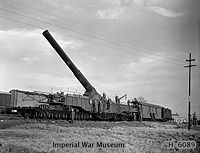 |
457.2 | BL 18 inch railway howitzer BL 18 inch railway howitzer The British Ordnance BL 18 inch howitzer on truck, railway was developed during World War I as part of the progression of ever-larger howitzers on the Western Front, but did not enter service until 1920.-History:... |
Railway howitzer Railway gun A railway gun, also called a railroad gun, is a large artillery piece, often surplus naval ordnance, mounted on, transported by, and fired from a specially designed railway wagon. Many countries have built railway guns, but the best known are the large Krupp-built pieces used by Germany in World... |
1920 |  United Kingdom United KingdomUnited Kingdom of Great Britain and Ireland The United Kingdom of Great Britain and Ireland was the formal name of the United Kingdom during the period when what is now the Republic of Ireland formed a part of it.... |
Elswick Ordnance Company |
 |
457.2 | BL 18 inch Mk I naval gun | Naval gun | 1916 |  United Kingdom United Kingdom |
Elswick Ordnance Company |
| 450 | RML 17.72 inch gun | Naval gun | 1877 |  United Kingdom United KingdomUnited Kingdom of Great Britain and Ireland The United Kingdom of Great Britain and Ireland was the formal name of the United Kingdom during the period when what is now the Republic of Ireland formed a part of it.... |
Elswick Ordnance Company | |
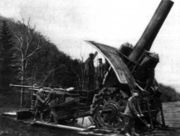 |
420 | Big Bertha Big Bertha (Howitzer) Big Bertha Bertha") is the name of a type of super-heavy howitzer developed by the famous armaments manufacturer Krupp in Germany on the eve of World War I... |
Howitzer Howitzer A howitzer is a type of artillery piece characterized by a relatively short barrel and the use of comparatively small propellant charges to propel projectiles at relatively high trajectories, with a steep angle of descent... |
 German Empire German Empire |
Krupp Krupp The Krupp family , a prominent 400-year-old German dynasty from Essen, have become famous for their steel production and for their manufacture of ammunition and armaments. The family business, known as Friedrich Krupp AG Hoesch-Krupp, was the largest company in Europe at the beginning of the 20th... |
|
| 420 | 42 cm Gamma Mörser 42 cm Gamma Mörser The 42 cm Gamma Mörser as it was known in World War II or, originally, the 42 cm kurze Marinekanone L/16 was a German siege howitzer. It was one in a series of super-heavy siege guns developed by Krupp before World War I, during that war the gun was used to attack the Kaunas Fortress... |
Mortar Mortar (weapon) A mortar is an indirect fire weapon that fires explosive projectiles known as bombs at low velocities, short ranges, and high-arcing ballistic trajectories. It is typically muzzle-loading and has a barrel length less than 15 times its caliber.... |
 German Empire / German Empire /  Nazi Germany Nazi Germany |
Krupp Krupp The Krupp family , a prominent 400-year-old German dynasty from Essen, have become famous for their steel production and for their manufacture of ammunition and armaments. The family business, known as Friedrich Krupp AG Hoesch-Krupp, was the largest company in Europe at the beginning of the 20th... |
||
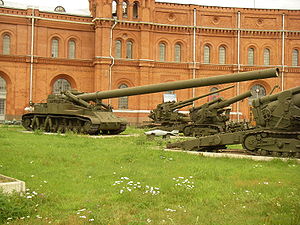 |
420 | 2B1 Oka 2B1 Oka 2B1 Oka is a Soviet 420 mm self-propelled gun. 2B1 is its GRAU designation.An experimental model was ready in 1957. Its chassis , was designed and built by the Kirov Plant. Its 20 meter barrel allowed it to fire 750 kg rounds up to 45 km. Due to its complexity of loading it had a... |
Mortar Mortar (weapon) A mortar is an indirect fire weapon that fires explosive projectiles known as bombs at low velocities, short ranges, and high-arcing ballistic trajectories. It is typically muzzle-loading and has a barrel length less than 15 times its caliber.... |
1957 |  Soviet Union Soviet Union |
|
 |
412.8 | BL 16.25 inch Mk I naval gun BL 16.25 inch Mk I naval gun The Elswick BL 16.25 inch naval gun was an early British superheavy breech-loading naval gun, commonly known as the 110-ton gun or 111-ton gun.-Service:... |
Naval gun | 1888 | Elswick Ordnance Company | |
| 410 | 41 cm/45 3rd Year Type | Naval gun |  Empire of Japan Empire of Japan |
|||
 |
406 | 16"/50 caliber M1919 gun | Gun Gun A gun is a muzzle or breech-loaded projectile-firing weapon. There are various definitions depending on the nation and branch of service. A "gun" may be distinguished from other firearms in being a crew-served weapon such as a howitzer or mortar, as opposed to a small arm like a rifle or pistol,... |
1920 |  United States United States |
|
 |
406 | BL 16 inch Mk I naval gun | Naval gun | 1927 |  United Kingdom United Kingdom |
|
 |
406 | 40.6 cm SK C/34 gun | Naval gun |  Nazi Germany Nazi Germany |
Krupp Krupp The Krupp family , a prominent 400-year-old German dynasty from Essen, have become famous for their steel production and for their manufacture of ammunition and armaments. The family business, known as Friedrich Krupp AG Hoesch-Krupp, was the largest company in Europe at the beginning of the 20th... |
|
| 406 | 2A3 Kondensator 2P 2A3 Kondensator 2P The 2A3 Kondensator 2P was a Soviet 406 mm Self-propelled Howitzer. 2A3 is its GRAU designation.2A3 originated during the Cold War when the United States created its new tactical doctrine called Pentomic Division which emphasized heavy use of nuclear weapons including nuclear artillery. M-65... |
Howitzer Howitzer A howitzer is a type of artillery piece characterized by a relatively short barrel and the use of comparatively small propellant charges to propel projectiles at relatively high trajectories, with a steep angle of descent... |
1956 |  Soviet Union Soviet Union |
||
| 406 | 406 mm/50 B-37 naval gun for BB Sovetskiy Soyuz Sovetsky Soyuz class battleship The Sovetsky Soyuz class battleships , also known as "Stalin's Republics", were a class of battleships begun by the Soviet Union in the late 1930s but never brought into service. They were designed in response to the battleships being built by Germany... |
Naval gun | 1937 |  Soviet Union Soviet Union |
Barrikady Plant, Stalingrad Volgograd Volgograd , formerly called Tsaritsyn and Stalingrad is an important industrial city and the administrative center of Volgograd Oblast, Russia. It is long, north to south, situated on the western bank of the Volga River... |
|
 |
406 | 16"/50 caliber Mark 7 gun for the Iowa class battleships. | Naval gun | 1943 |  United States United States |
Washington Navy Yard Washington Navy Yard The Washington Navy Yard is the former shipyard and ordnance plant of the United States Navy in Southeast Washington, D.C. It is the oldest shore establishment of the U.S. Navy... , Washington, D.C. Washington, D.C. Washington, D.C., formally the District of Columbia and commonly referred to as Washington, "the District", or simply D.C., is the capital of the United States. On July 16, 1790, the United States Congress approved the creation of a permanent national capital as permitted by the U.S. Constitution.... |

